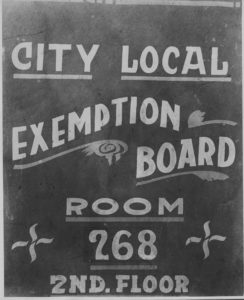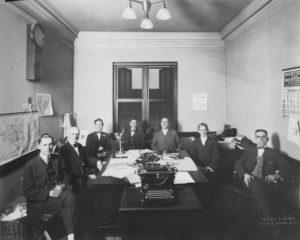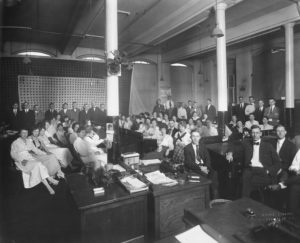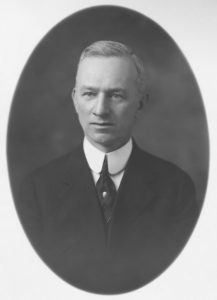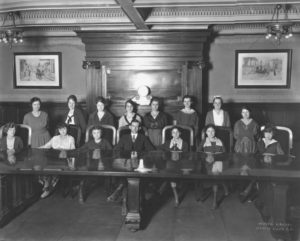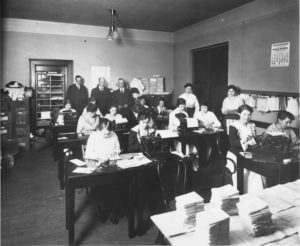September 12, 1918, was the date of the fourth scheduled selective draft registration in Winston-Salem. The other dates of the draft registration were June 5, 1917, June 5, 1918, and August 24, 1918. The draft was in operation to supply soldiers for World War I.
The first draft registration board consisted of former mayor Oscar B. Eaton, George W. Coan, and Dr. Fred Hanes. The mayor at this time was Robert W. Gorrell.
The first offices of the draft board were located in the O’Hanlon building. They moved later to the Starbuck Building (N. Liberty Street), then back to the O’Hanlon Building, then to the Post Office Building at Liberty, Fifth and Trade Streets. The sign board, that was placed at the foot of the stairs in the Post Office building to direct registrants to the Local Board offices on the second floor, is shown above.
Although the draft board offices were in one location on this day, the registrations that took place on the four dates required many locations and many people in order to handle all of the registrations and to investigate all of the requests for exemptions. In fact, there were over 500 individuals and firms that voluntarily aided the local draft board for the four registrations, without remuneration to them and without cost to the government.
The registration that took place on September 12th, 1918, was taken care of in one day’s time. This was a record of which the local board was justifiably proud. The men in the photograph shown above served on the local draft board on September 12th. The men are: Judge Charles A. Vogler, J. T. Wilson, C. C. Broughton, Judge Henry Starbuck, Judge Gideon Hastings, H. H. Dunn, and J. S. Kuykendall (Chief Registrar). The board members were compensated for their service.
Organizing such an event took a lot of time and forethought, particularly since all of the steps in the registration process required extensive clerical support. The number of registrants expected for the September registration, deemed National Registration Day, was 7,000 men. The above photo shows the clerical force at the R. J. Reynolds Tobacco Company.
Word of the National Registration Day was passed to the public through several sources, including through the churches. Letters were sent to ministers of local churches asking the ministers to announce the upcoming date and these important facts: the law is a military measure and will be rigidly enforced; the penalty for failure to register is one year in the Federal prison; a very small proportion of those who register will be called for military service, but all must register regardless of color or race, regardless of whether they are married or not, regardless of whether they are sick or well, regardless of whether they are in favor of the war or not, or whether they expect to be called or not. If a man reaches the age of 18, or does not reach his 46th birthday on or before the 12th of September, he must register.
Letters were also sent to the Forsyth County Sheriff (George W. Flynt), the Chief of Police (J. A. Thomas), Superintendent of the County Home (C. J. Mock), Superintendent of the County Road Force (R. T. Joyce), and Superintendent of City Hospital (Miss Katherine Rothwell). These individuals were asked to ascertain how many of their inmates were of draft age so that a Registrar could visit and register them.
Several doctors were on hand at the registration sites so that they could help when the potential registrant was unable to supply a birth date. Dr. J. K. Pepper, shown above, was in charge of scheduling doctors for the day.
The city was divided into four wards, each with a chief registrar, assistant chief registrar, and several assistant registrars. The registrars for the First Ward, located in the Tise Building on Main Street, are shown in the photo above.
On September 12th, chief registrars reported to the precincts at 6:30 a.m. Two clerks and one doctor were present at each registration precinct all day. Registration began at 7:00 a.m. and closed at 9:00 p.m. Registration card collection began at 8:30 a.m. There was a detailed procedure for taking the cards to the tabulating committee which was supervised by Mr. James A. Gray Jr. of Wachovia Bank & Trust Company. The photo above shows the clerical force at Wachovia Bank & Trust in the Director’s Room. Mr. C. C. Armfield, shown in the center of the group, was in charge of this clerical force.
On registration day, 4662 registrants filled out cards. All teams had completed their tasks by 9:30 p.m. and a telegram was sent to the Adjutant General of the State at Raleigh at 10:10 p.m.
At 10:30 p.m., Mr. Powell Gilmer and Mr. H. H. Teuber, were ready to drive the official registration party to Raleigh in two new Hudson super six automobiles. The cars were contributed by The Motor Company. The party was delayed in starting because they waited for the report from Forsyth County. The official party left Winston-Salem at 12:00 midnight. They drove two cars in case they experienced car trouble. They stopped in Greensboro for a meal, then completed their journey, 89 miles, arriving in Raleigh at 5:45 a.m. on September 13th. They were prepared to deliver their records to the Adjutant General at 6:15 a.m. A letter was mailed to North Carolina Governor Bickett from E. H. Crowder, Provost Marshal General, recognizing the accomplishment of the Winston-Salem draft board and commending them for “establishing a record of promptness in the dispatch of this important task that has been unexcelled throughout the nation.”
After the fourth registration, a report was made that compiled all of the data from the four registration dates. A total of 10,369 men were registered. The above photo shows the clerical force located at the local draft board office.
Photos courtesy of Forsyth County Public Library Photograph Collection.
Stay tuned for the next historical post on October 1st: Photo Essay: Dixie Classic Fair in 1957.

